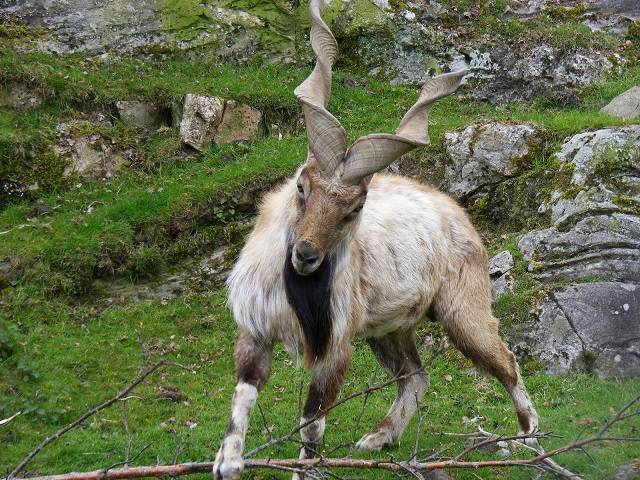By Hira Nauman
MARKHOR
Markhor is the “national animal of Pakistan”. It is indigenous mammal of large wild goats and is found in the mountainous regions of Pakistan (Hunza Nagar valleys, Giligit and Kashmir regions), Afghanistan and some parts of Uzbekistan and Tajikistan. The Markhor is a Persian word; mar means “snake” and khor means “eater. Though, they are found 500 to 3500 meters in elevation, an herbivorous animal and graze on grass, plants, leaves, flowers and herbs. ”. It has an ability to kill and eat snakes and drools of this appetite are used as an antidote to cure snake venom.
The biological name of Markhor is “Capra Faalconeri” which means “large Himalayan goat with spiraled horns”. It has long corkscrew shaped horns close to the end, the length of male horns are up to 160cm whereas females has small horns up to 25cm still larger than other goats and is easily distinguishable from others, due to their long winter hair which usually touches their male knees but shorter in females.
It usually weighs from 35 to 100kgs. It can attain the physical length of about 190cm with an average speed of 17km/h. The average life span of markhor is 10 to 13 years. The mammal usually matures during 18th to 20th month of their lives and breeds during winter. Their gestation period is 170 days long, after which usually two markhor babies are born. The babies are taken care by their mothers and they lives in the herd of nine animals while male markhor lives alone.
The markhor has been marked as a threatened species by the International Union for the Conversation of Nature and National Resources (IUCN) because it is at the verge of extinction with estimated population around the world is 3500 app. The existing population mainly consists of children and females. The reasons behind its increasing extinction are its predators (Snow leopard, wolf and lynx), deforestation and illegal hunting for its beautifully curled horns. The local authorities and governments should take steps to stop the hunting and take measures for the reservation of this beautiful species.
PARTRIDGES
Chukar Partridge is the “national bird of Pakistan”. Chukar belongs to the pheasant family “Phasianidae”. It is considered as an intense and often unrequited symbol of love.
“It is said to be in love with the moon, as it gaze at it constantly”.
It can be found in the steep and rocky open hillside regions of Pakistan, Nepal, India, Afghanistan, Turkey and Kashmir ranges with an altitude of 2000 to 4000m, but in Pakistan it can be found at the elevation of about 600m.
The length of the bird is about 32cm to 35cm with 14 feathers at its tail and an amazing colour scheme of grey chest, brown back, sandy colour belly, white face and red legs. The partridges feed on variety of insects, seeds and dust particles. The “eragrostis” seeds from Kashmir are their favorite appetite. It lives in conveys of 5 to 40 birds. It does not like humid and rainy weather and hence nests on hilly slopes with rocky offshores, above streams.
They breed during summers and females lay approximately 8 to 10 eggs collectively and 1 egg hatches daily during captivity. The chukar / partridges are not considered as an endangered species despite of its hunting. In time of danger or any disturbance, they prefer to run instead of flying. If necessary, it makes the flying for a shorter distance with their small rounded wings. It’s upwards flights and ability to vanish quickly in trees and bushes makes it’s hunting challenging for the hunters. Its species is not threatened by the hunters but climate conditions can harm it.
Regions: Pakistan, Afghanistan, Uzbekistan, Tajjikistan.
Markhor:”Snake eater”
Food: leaves, grass,plants.
Biological Name: Capra Faalconeri “large Himalayan goat with spiraled horns”
Weights: 35kgs to 100kgs
Length: 190cm approx.
Average Speed: 17km/h
Life Span: 10 to 13 years
Population: 3500 approx.
Conversation Status: Endangered species
Published in Young Nation on April 30, 2016







